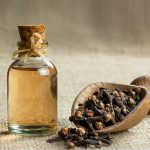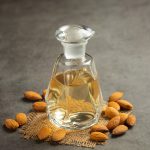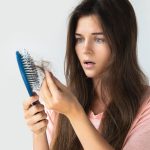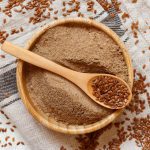Alarm bells inevitably tend to go off when you see your child scratching their head.…
Read MoreThe condition of our hair often reflects our internal health. Stress at work, pollution, poor diet, lack of exercise have all exacerbated our hair-related woes. From premature greying to hair fall, from rough frizzy hair to a dull lifeless mane, there seems to be no dearth of problems that can affect our hair. While cosmetic solutions help, what really gets to the root of the problem is focussing on internal health. Ayurveda does just that. It restores balance in the body and treats doshas using natural methods.
While there are several potent formulations in ayurveda, triphala is one that is used very commonly and is known to have a host of benefits.
Ayurveda describes it as a tridoshic rasayana, indicating that it is appropriate for people with vata, pitta, or kapha doshas. Studies have proven its benefits in maintaining gastrointestinal health, fighting diabetes, improving cardiovascular health, and more.[1]Peterson, Christine Tara, Kate Denniston, and Deepak Chopra. “Therapeutic uses of Triphala in Ayurvedic medicine.” The Journal of Alternative and Complementary Medicine 23, no. 8 (2017): … Continue reading Let us delve a little deeper.
Triphala is a potent combination of three fruits (tri = three and phal = fruits) that restores balance in the body and rejuvenates one’s health. Triphala has equal proportions of amla or Phyllanthus emblica, bibhitaki or Terminalia bellerica, and haritaki or Terminalia chebula.
Our skin and hair are mirrors of our health. Triphala’s antioxidant properties and its ability to maintain gastrointestinal health go a long way in ensuring that our body functions optimally, and this is reflected in the condition of our hair.
But before we look at how we can use triphala for our hair, let us understand what ayurveda reveals about the formation of hair.
According to ayurveda our body is made up of seven dhatus or elements: rasa (internal and external fluid), rakta (blood), mansa (muscles), meda (adipose tissue), asthi (bone and cartilage), majja (bone marrow), and shukra (reproductive tissue). Most ayurvedic practitioners believe that the metabolism of one kind of dhatu leads to the formation of the next one through the action of their respective agni (fire). For instance, raktagni transforms parts of the rasa dhatu to rakta, and so on. As the next dhatu is created, the body also creates upadhatu or mala (waste) from the previous dhatu. When asthi dhatu is metabolized to form majja dhatu, hair and nails emerge as mala.
The active ingredients in triphala, like amla, haritaki, and bibhitaki, have antioxidant and antimicrobial properties that help in fighting scalp infections that often hamper hair growth.
Triphala is one of the best formulations used to restore gut health. Due to poor dietary habits and a sedentary lifestyle, almost every other person today suffers from irregular bowel movements and digestive issues. Triphala cures these ailments and ensures optimum nutrient absorption. This stimulates the growth of new hair follicles.
Our body has an enzyme called 5⍺-reductase or 5-AR that converts the hormone testosterone into the more potent dihydrotestosterone (DHT). The more 5-AR our body produces, the higher are the levels of DHT, and this eventually causes hair loss. A study discovered that amalaki, one of the main components of triphala, inhibits 5-AR and helps prevent hair loss.[5]Kumar, Naphatsorn, Wandee Rungseevijitprapa, Nual-Anong Narkkhong, Maitree Suttajit, and Chaiyavat Chaiyasut. “5α-reductase inhibition and hair growth promotion of some Thai plants … Continue reading
Exposure to harmful ultraviolet rays, pollution and dust, and chemical treatments rob the hair of its natural luster, leaving it looking limp and lifeless. Triphala effectively gets rid of these external toxins. It closes the cuticles and locks the fatty acids inside the hair follicles, thus restoring its natural shine. This also helps in minimizing frizzy hair.
Recent experiments have proved how amla, a key component of triphala, enhances the tensile strength of virgin hair and bleached hair.[6]Tiampasook, Pratya, Chaiyavat Chaiyasut, Bhagavathi Sundaram Sivamaruthi, Thanaroat Timudom, and Duangporn Nacapunchai. “Effect of Phyllanthus emblica Linn. on tensile strength of virgin and … Continue reading
Oxidative stress is often the root cause of premature greying. But what is oxidative stress? The human body naturally produces free radicals, which are oxygen-containing molecules that have free electrons. These electrons make the molecules highly reactive. While free radicals can neutralize disease-causing pathogens, they can also be harmful to the body if they exist in excess. They need to be balanced by antioxidants. When this balance is off, it leads to oxidative stress, which can cause a lot of damage, including premature greying. Triphala has powerful antioxidant properties that fight free-radical damage and addresses the root cause of premature greying. Vitamin E in amla is a powerful antioxidant that battles oxidative stress effectively, while bibhitaki is known to nourish hair and prevent greying.[7]Kumar, Narendra, and S. M. Khurana. “Phytochemistry and medicinal potential of the Terminalia bellirica Roxb.(Bahera).” Indian Journal of Natural Products and Resources (IJNPR)[Formerly … Continue reading
Triphala, the commonly used Ayurvedic formulation, has a plethora of benefits. Here are a few of them:
Precaution: Since triphala is known to bring down sugar levels, consult your physician if you are already on any kind of prescribed medication, especially for diabetes. Also, check for any allergic reactions.
Triphala is a powerhouse of nutrients that can resolve your hair-related woes. However, good hair depends on your overall internal health. A single herbal formulation is not a substitute for a holistic healthy lifestyle. So, make sure that you are eating a balanced diet, exercising regularly, and getting a good night’s sleep in addition to reaping the benefits of this wonderful herbal product!
References
| ↑1, ↑8 | Peterson, Christine Tara, Kate Denniston, and Deepak Chopra. “Therapeutic uses of Triphala in Ayurvedic medicine.” The Journal of Alternative and Complementary Medicine 23, no. 8 (2017): 607-614. |
|---|---|
| ↑2 | Goraya, Rajpreet Kaur, and Usha Bajwa. “Enhancing the functional properties and nutritional quality of ice cream with processed amla (Indian gooseberry).” Journal of food science and technology 52, no. 12 (2015): 7861-7871. |
| ↑3 | Dharmaratne, M. Priyanga Jayamal, Amirthasingam Manoraj, Vasanthi Thevanesam, Asela Ekanayake, Nimal Savitri Kumar, Veranja Liyanapathirana, Eranga Abeyratne, and BM Ratnayake Bandara. “Terminalia bellirica fruit extracts: in-vitro antibacterial activity against selected multidrug-resistant bacteria, radical scavenging activity and cytotoxicity study on BHK-21 cells.” BMC complementary and alternative medicine 18, no. 1 (2018): 1-12. |
| ↑4 | Bag, Anwesa, Subir Kumar Bhattacharyya, and Rabi Ranjan Chattopadhyay. “The development of Terminalia chebula Retz.(Combretaceae) in clinical research.” Asian Pacific journal of tropical biomedicine 3, no. 3 (2013): 244-252. |
| ↑5 | Kumar, Naphatsorn, Wandee Rungseevijitprapa, Nual-Anong Narkkhong, Maitree Suttajit, and Chaiyavat Chaiyasut. “5α-reductase inhibition and hair growth promotion of some Thai plants traditionally used for hair treatment.” Journal of ethnopharmacology 139, no. 3 (2012): 765-771. |
| ↑6 | Tiampasook, Pratya, Chaiyavat Chaiyasut, Bhagavathi Sundaram Sivamaruthi, Thanaroat Timudom, and Duangporn Nacapunchai. “Effect of Phyllanthus emblica Linn. on tensile strength of virgin and bleached hairs.” Applied Sciences 10, no. 18 (2020): 6305. |
| ↑7 | Kumar, Narendra, and S. M. Khurana. “Phytochemistry and medicinal potential of the Terminalia bellirica Roxb.(Bahera).” Indian Journal of Natural Products and Resources (IJNPR)[Formerly Natural Product Radiance (NPR)] 9, no. 2 (2018): 97-107. |


Dr. Aswathy has 10+ years of experience as an Ayurvedic consultant and medical officer in different nursing homes and hospitals. She has a deep knowledge of classical texts, Ayurvedic treatments, and Panchkarma. Dr. Aswathy is proficient in diagnosis through traditional Ayurvedic means and plans treatment that is specific to an individual’s constitution.

Alarm bells inevitably tend to go off when you see your child scratching their head.…
Read More
Sometimes hair loss can be caused by fairly simple things like hot oil hair treatments,…
Read More
We can’t help but get a little worried when we notice hair falling out as…
Read More
Don’t we all feel a tinge of envy when we see a shampoo ad? Who…
Read More